|
|
 |
|
Calanoida ( Order ) |
|
|
|
Clausocalanoidea ( Superfamily ) |
|
|
|
Pseudocyclopiidae ( Family ) |
|
|
|
Stygocyclopia ( Genus ) |
|
|
| |
Stygocyclopia balearica Jaume & Boxshall, 1995 (F,M) | |
| | | | | | | Syn.: | Paracyclopia gitana Carola & Razouls, 1996 (p.348, figs.M) | | | | Ref.: | | | Jaume & Boxshall, 1995 (p.213, figs.F,M); Jaume & al., 1999 (p.414, Rem.); Vives & Shmeleva, 2007 (p.711, figs.F,M, Rem.) | 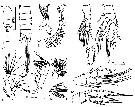 issued from : M. Carola & C. Razouls in Bull. Mar. Sci., 1996, 58 (2). [p.349, Fig.2]. As Paracyclopia gitana. Male (from Sa Gamba cave, Minorca): A, habitus (dorsal); B, urosome (dorsal); C, forehead (lateral); D, A1; E, A2; F, Md; G, Mx1; H, Mx2; I, Mxp; J, P1; K, P2; L, P3; M, P4; N, P5. Nota: Cephalosome and 1st pedigerous segment , 4th and 5th segments not fused. - Urosome 5-segmented almost equal, each armed with fine spinules on lateral and ventral margins. - Caudal rami symmetrical armed with 3 strong distal setae and 1 fine seta on both outer and inner margins. - A1 22-segmented, extending up to posterior margin of prosome. A2 biramous, endopod longer than exopod (= 1.7); coxa and basis completely separated; basis armed with 1 seta; endopod 2-segmented, segment 1 with 2 groups of 2 setae each, segment 2 with 9 setae on subapical lobe and 5 on apical lobe; exopod 6-segmented, segment 1 with 1 seta, segment 2 with 5 setae, segment 3 and 4 with 1 seta each, segment 5 witout sera, and segment 6 with 3 distal setae. - Distal margin of gnathobase of Md with 4 cuspidate teeth and 2 exterior stronger; palp biramous; basis with 3 inner setae; endopod 2-segmented, proximal segment with 1 seta, distal segment with 8 setae; exopod indistinctly 4-segmented, segments 1 to 3 each with 1 inner seta, segment 4 with 3 apical setae. - Mx1 with precoxa produced into powerful endite bearing 9 stout spines and 4 setae; coxa with 2 setae on endite; outer lobe (epipodite) represented by 2 setae; basis fused to endopod, lacking outer seta; proximal endite bearing 2 setae; distal endite, fused with the endopod, armed with one group of 6 setae on inner margin; free apical segment with 6 setae; exopod 1-segmented, with 8 setae along distal and lateral margins. - Mx2 small, , comprising precoxa and coxa each armed with 2 endites; basis with 1 endite; endopod 3-segmented; proximal and distal precoxal endites with 5 and 3 setae respectively; both proximal and distal coxal endites with 3 setae; endite of basis powerful, bearing 1 stout spine and 2 setae; endopod segments 1 and 2 each with 1 seta, segment 3 with 2 setae. P5 uniramous, left leg with 5 segments, right leg with 4; all segments have small setules or spinules on inner or outer margins.
|
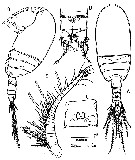 issued from : D. Jaume & G.A. Boxshall in Sarsia, 1995, 80. [p.215, Fig.2]. Female (from Mallorca, Balearic Islands): A-B, habitus (dorsal and lateral, respectively); C, genital double-somite (ventral); D, anal somite and caudal rami (dorsal); E, left A1 (ventral).
|
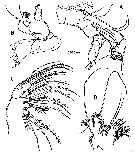 issued from : D. Jaume & G.A. Boxshall in Sarsia, 1995, 80. [p.216, Fig.3]. Female: A, A2; B, Md; C, Mx2; D, Mx1.
|
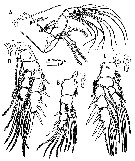 issued from : D. Jaume & G.A. Boxshall in Sarsia, 1995, 80. [p.217, Fig.4]. Female: A, Mxp; B, P1 (posterior); C, P2 (anterior); D, P3 (posterior).
|
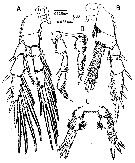 issued from : D. Jaume & G.A. Boxshall in Sarsia, 1995, 80. [p.218, Fig.5]. Female: A, P4 (anterior); B, P4 (posterior); C, P5 (posterior). male: D, P5 (posterior).
|
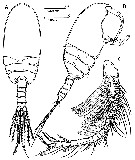 issued from : D. Jaume & G.A. Boxshall in Sarsia, 1995, 80. [p.219, Fig.6]. Male: A-B, habitus (dorsal and lateral, respectively); C, left A1.
| | | | | Compl. Ref.: | | | Krsinic, 2012 (p.1537, Rem.); 2015 (p.9: Rem.) | | | | NZ: | 2 | | |
|
Distribution map of Stygocyclopia balearica by geographical zones
|
| | | | | | | Loc: | | | Canary Islands (Lanzarote Is.), Medit. (Minorca cave, Baleares), Adriatic Sea (Urinj Cave, Lenga Pit, Adriatic Sea) | | | | N: | 4 | | | | Lg.: | | | 508) F: 0,69-0,68; M: 0,62-0,59; (509) M: 0,6; {F: 0,68-0,69; M: 0,59-0,62} | | | | Rem.: | in submarine excavations.
For Jaume & al. (1999, p.414, 415) the segmentation of the mandibular exopod in S. balearica is reinterpreted as 3-segmented as in S. philippinensis with formula (1 + 1), 1, 3, rather than 4-segmented with setal formula 1, 1, 1, 3.
Comparison between the Lanzarote's material with the species type has demonstrated that the Canarian forms belongs to S. balearica. The comparative study has also revealed several character states which were incorrectly determined in the original description by Jaume & Boxshall (1995). The number of segments of the A1 female was found to be variable: the failure to express of the articulation between ancestral segments XXII and XXIII is constant in males but not so in females. Only 3 (including the allotype and 1 paratype) out of 33 Balearic females examined for this character displayed failure to express this articulation, the remaining females dispkayed a 23-segmented condition. This is the condition displayed by all Canarian females examined. Another trait to be emended in both sexes from the original description concerns the nature of the armature element on the anteroventral margin of the penultimate segment of A1; this element was shown as an ordinary seta, but its appearance is intermediate between a seta and an aesthetasc (as represented for P. philippinensis).
Other inaccuracies of the original description involve counts of setae on segments of the A2, Mx1, Mx2 and Mxp.
The paired patches of tiny setules described as located on the lateral surfaces of the 5th pedigerous somite in the original description, are actually positioned on the inner surface at both sides of somite.
The urosomal somites are adorned with lamellar spinules as in S. philippinensis, although they are easily lost when manipulating individuals.
For Jaume & al. (1999, p.416) the discovery of S. balearica in anchialine environments of Lanzarote (Canary Islands) is amazing. The Canaries and the western Mediterranean islands share common, cave-dwelling marine genera exhibiting globally very localised, relictual distributions, but they are represented by vicariant species at each site. If S. balearica dwells exclusively in the essentially discontinuous, anchialine environment, it is difficult to explain why the balearic and Canarian populations have not differentiated. Jaume & Boxshall (1996) postulated that the lack of morphological differentiation might indicate that this taxon is more widely distributed (and less isolated) than reported, or its morphology is highly conservative over evolutionary time | | | Last update : 11/05/2016 | |
|
|
 Any use of this site for a publication will be mentioned with the following reference : Any use of this site for a publication will be mentioned with the following reference :
Razouls C., Desreumaux N., Kouwenberg J. and de Bovée F., 2005-2024. - Biodiversity of Marine Planktonic Copepods (morphology, geographical distribution and biological data). Sorbonne University, CNRS. Available at http://copepodes.obs-banyuls.fr/en [Accessed April 19, 2024] © copyright 2005-2024 Sorbonne University, CNRS
|
|
 |
 |









